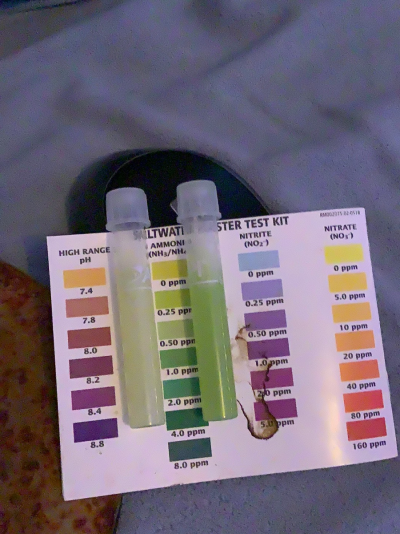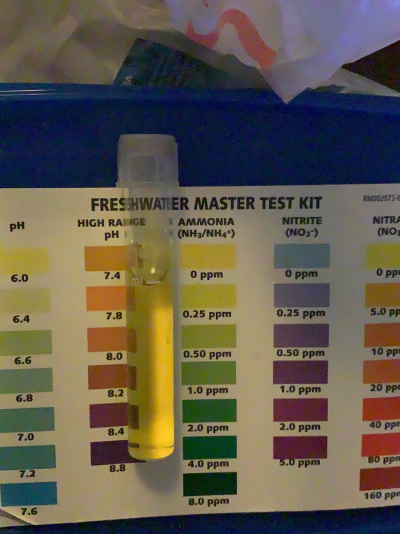First off, I'll just say I'm one sad fish dad. One by one my fish and corals are dying. It's my first reef and my 5 fish were buddies for 2 years. Not a single death until this week.
INSTANT OCEAN REEF CRYSTALS crashed my reef with ammonia. I didn't believe it at first but the tests feel conclusive.
The picture with 2 tubes:
Left: RODI+salt mix (from a pitcher of water with a drop of AmmoLock)
Right: RODI+salt mix
The picture with 1 tube:
Just RODI
Is it in my bucket? Nope, I tested it with a clean pitcher, exact same result. Nothing else touches the water prior to testing.
I have 2 boxes of mix that were ordered several months apart. One brand new, the other about 4 months old. They BOTH produced the same result (as seen in the pic).
All of the tests were done to water that was tank-ready, salinity and temp on par. I'm happy I didn't dump it into the tank but that also mean I'm just letting it die until I get new salt first thing tomorrow. I really hope AmmoLock and bacteria additives can save what little is left (1 clown and a few frags).
My tank is currently testing better than the right tube and worse than the left (forgot to take a photo but it's somewhat irrelevant in this thread).
My question is, how is it possible INSTANT OCEAN REEF CRYSTALS could produce 0.7ppm ammonia seawater? They're just selling poison? Is that not the point when doing a water change, to remove bad stuff while introducing good stuff?
It was traumatic to watch it crash after enjoying it to the max, stuck in a small apartment downtown during a pandemic. However I realize other reefers have incurred much bigger losses and my heart goes out to anyone who has to go through it.


INSTANT OCEAN REEF CRYSTALS crashed my reef with ammonia. I didn't believe it at first but the tests feel conclusive.
The picture with 2 tubes:
Left: RODI+salt mix (from a pitcher of water with a drop of AmmoLock)
Right: RODI+salt mix
The picture with 1 tube:
Just RODI
Is it in my bucket? Nope, I tested it with a clean pitcher, exact same result. Nothing else touches the water prior to testing.
I have 2 boxes of mix that were ordered several months apart. One brand new, the other about 4 months old. They BOTH produced the same result (as seen in the pic).
All of the tests were done to water that was tank-ready, salinity and temp on par. I'm happy I didn't dump it into the tank but that also mean I'm just letting it die until I get new salt first thing tomorrow. I really hope AmmoLock and bacteria additives can save what little is left (1 clown and a few frags).
My tank is currently testing better than the right tube and worse than the left (forgot to take a photo but it's somewhat irrelevant in this thread).
My question is, how is it possible INSTANT OCEAN REEF CRYSTALS could produce 0.7ppm ammonia seawater? They're just selling poison? Is that not the point when doing a water change, to remove bad stuff while introducing good stuff?
It was traumatic to watch it crash after enjoying it to the max, stuck in a small apartment downtown during a pandemic. However I realize other reefers have incurred much bigger losses and my heart goes out to anyone who has to go through it.





















